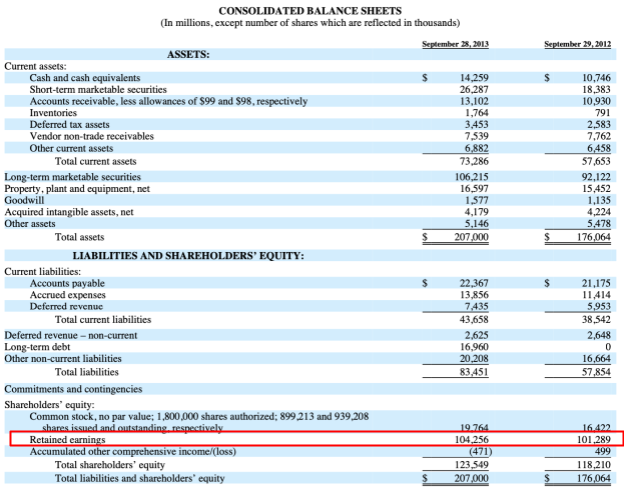What are Retained Earnings? How to Calculate Retained Earnings?

Retained earnings are a cornerstone of financial analysis for businesses, yet understanding and utilizing them effectively can pose challenges. In this concise guide, we’ll explore the essentials of retained earnings, offering actionable insights to help businesses unlock their potential for growth and financial stability.
Whether you’re a seasoned entrepreneur or new to financial management, this guide will provide the clarity and guidance you need to make informed decisions about your company’s finances.
What are retained earnings?
Retained earnings (RE) represent the net income of a company after paying all costs such as employee salary, tax, and dividends to shareholders. The RE will be used for future reinvestment. Typically, these funds are used for things like covering day-to-day expenses, buying assets, or paying off debts.
Where to find retained earnings
Retained earnings are reflected in two specific sections within your business’s financial statements. Now, take a look at the financial statements of Apple in fiscal year 2013:

- At the end of your Income Statement (also known as the Profit and Loss Statement), where they appear as the final figure.
- In the shareholder’s equity segment of your Balance Sheet.
Now, let’s delve into where you can locate the necessary figures and the steps to compute your retained earnings.
The meaning of retained earnings
Retained earnings embody a company’s past profits minus any dividends disbursed. Understanding their significance unveils various avenues through which surplus funds can be utilized within the business.
Firstly, dividends distribute income among shareholders, leading to a permanent exit of earnings from the company’s financial records. Conversely, other options retain earnings for internal utilization, comprising investments and funding activities.
These include:
- Dividend distribution to shareholders.
- Investment in expanding existing operations, such as augmenting production capacity or hiring additional sales representatives.
- Investment in launching new products or variants, like branching into air conditioner production or introducing flavored variants for a cookie manufacturer.
- Funding mergers, acquisitions, or partnerships to enhance business prospects.
- Executing share buybacks.
- Repaying outstanding debts, impacting the company’s accounts, for instance, by reducing future interest payments.
Retained earnings, also termed earnings surplus, serve as reserve funds for management reinvestment. When represented as a percentage of total earnings, it’s known as the retention ratio, equal to (1 - dividend payout ratio).
Despite debt repayment seemingly expelling money from the business, it influences the company’s financial accounts, potentially conserving future interest payments, thus qualifying for inclusion in retained earnings.
Profits afford considerable flexibility to business owners or management for surplus fund utilization. While often distributed to shareholders, they can also be reinvested for business growth, with unallocated funds constituting retained earnings.
Key factors to calculate retained earnings
Now that we have a clear understanding of what retained earnings represent and their significance, let’s delve into the calculation process. To determine your retained earnings, you’ll require three essential pieces of information:
1. Identify your beginning retained earnings balance
Retained earnings accumulate over time, transitioning from one period to the next. Therefore, to initiate the computation of your current retained earnings, you need to ascertain their value at the beginning of the timeframe under consideration, typically the preceding quarter or year. This initial retained earnings figure can be located on your Balance Sheet from the previous period.
2. Determine your net income (or loss) for the current period
Essentially, this refers to the profit generated by your business. It represents the residual income after deducting your business expenses from the total revenue or sales. This figure is obtainable from your Income Statement.
3. Calculate dividends distributed to shareholders quarterly or annually
If your business disburses dividends to shareholders, you’ll need to deduct the total dividends paid from your initial retained earnings balance. However, if dividends are not distributed, this step can be disregarded, and you can substitute $0 for this aspect of the retained earnings formula.
The retained earnings formula
Have you gathered all the necessary figures? It’s time to break out the calculator. Here’s the fundamental formula for computing retained earnings:
RE = RE௦ + NI - D
RE: Retained earnings
RE௦: Beginning retained earnings
NI: Net income (profit or loss)
D: Dividend
As evident, once you’ve compiled all the required data, the calculation is straightforward—no flashbacks to the trigonometry class needed.
An example of retained earnings calculation
Let’s examine an example of our formula in action using real-world scenarios. BeSpoke, a fashion local brand in Brazil, is considering bringing on an investor to facilitate the expansion of the shop into multiple locations. The potential investor is interested in understanding the current status of retained earnings.
The financials for the most recent quarter are outlined as follows:
- Beginning retained earnings: $150,000
- Net income: $25,000
- Dividends paid: $15,000
Applying BeSpoke’s retained earnings formula:
[$150,000] (Beginning retained earnings) + [$25,000] (Net income) - [$15,000] (Dividends paid) = $160,000
This indicates that BeSpoke currently possesses $160,000 in retained earnings—funds that she can allocate toward the endeavor of opening additional bookstore locations.
Difference between retained earnings and revenue
It’s common to confuse retained earnings with revenue. So, what sets them apart?
Impacts of net income
- Revenue: Not directly related. Revenue tells you the total income from sales, but not what’s left after expenses.
- Retained Earnings: Directly impacted. Net income (profit after expenses) is added to retained earnings at the end of the period, increasing it.
Impact of dividends
- Revenue: Not impacted. Dividends are paid out of profits, not revenue itself.
- Retained Earnings: Reduced. When dividends are paid to shareholders, they come from retained earnings, decreasing it.
Method of identifying financial statements
- Revenue: Not relevant. Revenue is a measure of income for a specific period, it doesn’t carry over.
- Retained Earnings: Cumulative figure. It reflects the accumulated profits (net income minus dividends) over the life of the company.
How much should my retained earnings be?

If you followed along with our example earlier and calculated your retained earnings, you now have a figure in hand. But what exactly does that number signify? Understanding financial amounts becomes meaningful when you grasp what they ought to be.
Typically, retained earnings are evaluated in relation to a company’s total assets. The ideal ratio between retained earnings and total assets is 1:1, or 100%. However, achieving this ratio is often impractical for most real-world businesses, so there’s no need to fret if you’re not quite there yet.
The reality is that retained earnings figures vary across different businesses—there’s no universal target to aim for. Nonetheless, a feasible objective is to strive for a ratio that approaches 100 percent, considering industry averages. Subsequently, the aim is to enhance retained earnings from one period to the next.
Limitations of retained earnings calculations
Understanding retained earnings is crucial for business owners due to its significance in various scenarios. However, there are drawbacks associated with it:
Skewed perspective in quarterly calculations
Retained earnings calculations conducted quarterly may provide a distorted view, especially for businesses with seasonal operations like lawn care or snow removal.
Fluctuations in retained earnings from one quarter to the next may fail to offer a comprehensive overview of financial status, thus potentially misrepresenting the business’s financial health.
High retained earnings as a red flag
Excessive retained earnings can suggest inefficiency in spending or a lack of reinvestment in business growth. Therefore, high retained earnings might indicate underutilized funds that could have been allocated more effectively.
Such situations could raise concerns among investors, highlighting the importance of regular bank reconciliations to ensure efficient capital utilization.
Despite these drawbacks, calculating retained earnings is essential for identifying and addressing potential issues. It serves as a vital tool for business improvement. It’s imperative to interpret retained earnings within the context of business realities, such as seasonality, to make informed decisions that promote earnings growth and overall business development.
Conclusion
Retained earnings serve as a critical indicator of a company’s financial health and its ability to reinvest in growth opportunities. While retained earnings offer valuable insights into a company’s performance and potential, it’s crucial to interpret them within the context of the business’s operations and industry standards. By leveraging retained earnings effectively, businesses can make informed decisions to drive sustainable growth and enhance shareholder value.





![Top 20+ Must-have Shopify Apps for 2025 [Free & Paid] - Mageplaza](https://cdn2.mageplaza.com/media/blog/must-have-shopify-apps/top-must-have-shopify-apps.png)
![[2025 Updates] Top 10+ Upsell Apps for Shopify - Mageplaza](https://cdn2.mageplaza.com/media/blog/best-upsell-shopify-app/cover.png)